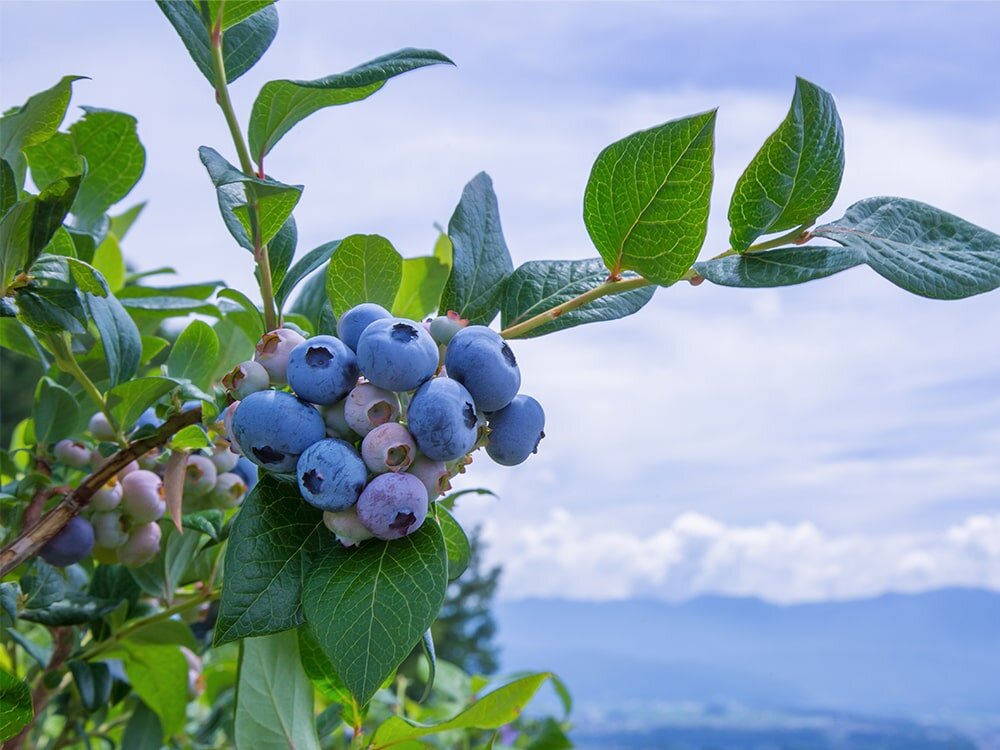Blueberries are a popular plant for home gardeners. Depending on variety, the blueberry season can extend from late June through September. Individual varieties will bear fruit over a 2-5 week period. Note that blueberry varieties offered will vary each season. The most common type of blueberry grown in Oregon is the northern high bush blueberry. These are long-lived (40-50 years) deciduous shrubs that are also attractive as ornamental landscape plants. Other types include southern high bush and wild low bush varieties.
 While most blueberry cultivars are self-fertile, cross pollination with another cultivar will produce larger berries and a more bountiful crop. To ensure cross-pollination, plant more than one cultivar that fruit in the same season (for example, two early season varieties will cross pollinate each other). The table below lists examples of common blueberry varieties:
While most blueberry cultivars are self-fertile, cross pollination with another cultivar will produce larger berries and a more bountiful crop. To ensure cross-pollination, plant more than one cultivar that fruit in the same season (for example, two early season varieties will cross pollinate each other). The table below lists examples of common blueberry varieties:
 While most blueberry cultivars are self-fertile, cross pollination with another cultivar will produce larger berries and a more bountiful crop. To ensure cross-pollination, plant more than one cultivar that fruit in the same season (for example, two early season varieties will cross pollinate each other). The table below lists examples of common blueberry varieties:
While most blueberry cultivars are self-fertile, cross pollination with another cultivar will produce larger berries and a more bountiful crop. To ensure cross-pollination, plant more than one cultivar that fruit in the same season (for example, two early season varieties will cross pollinate each other). The table below lists examples of common blueberry varieties:
| Variety | Type | Fruiting Season |
| Duke | Northern High bush | Early season |
| Bluecrop | Northern High bush | Mid season |
| Elliot | Northern High bush | Late season |
| O’Neal | Southern High bush | Early season |
| Top Hat | Wild Low Bush | Mid season |
Site Selection
Blueberries require full sun (six to eight hours of sunlight per day) for optimum yield. Grow best in acidic soil pH should be in the range of 4.5 to 5.5. Use a soil tester to determine your range. Application of sulfate of ammonia, can help lower you pH if needed. The use of lime can help increase your pH if needed, always check application rates suggested. Blueberry plants are shallow rooted and require soil that holds moisture well, but are also well-drained. Adding organic matter such as peat moss, well rotted manure, compost and aged sawdust will help with moisture retention.
Planting
Spring or fall are the best planting times for Blueberries. After site selection, you should dig your holes. Two to three times the size of the root system, 3 to 4 feet apart. Mix the garden soil with a good com- post/planting medium. Spread the root system out, position the root crown evenly at the soil surface and backfill with the soil mixture you prepared. Water thoroughly. Remove blossoms. Prune off flower buds the first year, it is important they grow well the first year, and fruit production hinders their growth.Mulching
Blueberries grow better when mulched. Mulching keeps the soil cool, conserves moisture, adds organic matter to the soil and aids in weed control. Use Sawdust or Peat moss to mulch 1 to 2 inches deep.
Fertilizing
First year - about 4 weeks after planting a good simple fertilizer can be used, keep the fertilizer application at least 6” from the plant stem. Fertilizers that are made for acid loving plants can be used-Rhododendron food. Years following use a soil tester to determine needs, yearly feeding is recommended.We would love to see your planting projects, use #mywilcolife on Facebook, Twitter, or Instagram and tag Wilco Stores.
Orders
Services
About
Your Wilco Store
Store Hours
Monday to Saturday:
8 a.m. to 8 p.m.
Sunday: 9 a.m. to 6 p.m.
Need Help?
For questions or help with online orders call: (888) 78-WILCO
Limited to stock on hand. Some items may vary from photos. Because of store size limitations or geography, some items featured may not be available in all stores but will be made available by special order during sale periods at advertised prices. All sale prices listed as “dollars off” or “% off” are discounted from our regular posted shelf price, not from discounts given with specialty, bulk or pallet pricing. Reseller and Drop-shippers must contact us for pre-approval to place orders with the intent to re-distribute.
© 2025, Wilco Farm Store
